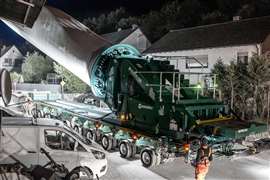Good problems
18 April 2008
A year ago, US crane distributors had bid good riddance to 2004, another marginal year for crane sales, but were optimistic and hopeful that 2005 would be the year the market would “open up.” Within the first three months of 2005 those hopes were fulfilled with a surge in orders for new cranes.
By ConExpo in March, the industry was amid a strong rally, with dealers scurrying to place orders for cranes their customers needed or anticipated needing. By summer, manufacturers were reporting backlogs well into 2006.
“Getting cranes has definitely been a problem and we have been slowing down our used equipment sales to keep our equipment longer while we wait on new cranes,” says Dan Gold, vice president of subsidiary operations for All Erection and Crane Rental, based in Cleveland. “We don't see much of a relief judging by what the manufacturers are telling us on deliveries.”
Component shortages
Component shortages are taking the blame for manufacturers' inability to get product out the door and to their dealers, Gold says, with steel and tire shortages a major problem.
“In some cases, we have heard of equipment sitting because there aren't any tires for them,” says Gold, whose company owns several traditional dealerships as well as crane rental operations, and represents Link-Belt, Manitowoc, Grove, and Piner to name a few brands.
Steve Nixon, owner and president of Link-Belt dealer Nixon Egli based in Ontario, CA, says backlogs have not been as much of a problem for his company because he ordered well in 2004 and 2005.
“We ordered a bunch of cranes last year and have multiple units ordered for 2006, with most of them pre-sold,” he says. “It could be a problem the second half of this year because I may not have anything to sell.”
Having just sold three 100-ton rough terrain cranes at year end, Nixon says he anticipates getting new cranes could become an issue if the construction economy keeps the pace of the past year.
“How bad [delivery] is, depends on how good the economy is,” he says. “If the economy slows, it may not be an issue.”
Carston Larson, vice president of Milwaukee-based American State Equipment, says getting new equipment for most dealers has been “terrible,” but that ordering in advance and having good, long-term relationships with the manufacturers has helped his company.
“Grove, Kobelco and Liebherr have been good to facilitate our requirements and demands, but it helped that we ordered well in advance,” he says.
For the most part, 2005 was a very stable year for dealers across the US, with few mergers, acquisitions and bankruptcies reported, as compared to the rash of such during 2001 through 2003, which changed the face of crane distribution in the US.
All is calm
“It has settled down,” says Nixon. “A lot of the dealers that were acquired were those who had gotten in trouble and were leveraged - it was be acquired or go out of business. People tend to hold on when times are good.”
Larson says that most of the merger and acquisition activity among dealers went on in the South and the West, and was not that big an issue in the Midwest.
“We are all pretty much independent dealers up here,” he says. “Some of these big dealers [in the South and West] have become huge.”
As well, the merger activity in the manufacturing sector also caused havoc. This too has settled down, although some dealerships fared better than others with all the changes.
“We have been a Grove dealer since 1961,” says Larson. “When they were acquired by Manitowoc, it afforded us some more opportunities.”
Gold says all the consolidations leveled the playing field and made it smaller.
“There are fewer manufacturers and fewer distributors, both,” says Gold. “Right now things are positive for almost everyone.”
Labor shortage
After backlogs, dealers report the biggest issue for them is luring, hiring and retaining quality product support personnel. Larson says this problem is industry wide and almost at a critical level.
“I think we as an industry need to address this and be more proactive,” he says. “We've gone into schools, we've gone into allied industries. We've tried to bring young people on board and some work and some don't. This is a tough issue.”
Gold says workforce shortages are “incredible” and that his company has taken to advertising for personnel non-stop, putting signs out in front of the dealership.
“There's an incredible shortage of mechanics and product support people,” he says. “What we have done is hire young men with no experience and start them cheap and raise them fast and give them enough money [to want to stay] and [even] loan them money for their tools.”
Gold says he has found “stealing” mechanics and product support people from competitors doesn't wok out, either. And the problem is not a new one.
“In the last 20 years, there has been maybe six months where we were not looking for mechanics,” he says.
Nixon says labor shortages are especially hard for the smaller dealers.
“The bigger companies can recruit the talented people because they can offer more benefits and more security,” he says. “It's a major issue for us.”
Most concur that the shortage of product support personnel is due to high school students not being as interested in construction work as much as they are interested in computers and high technology.
“Many schools aren't offering mechanics and auto shop [classes] any more,” says Nixon.
Larson is pleased to see local Associated General Contractor groups and organizations like AED and SC&RA beginning to address labor shortages on an industry wide level.
STAY CONNECTED


Receive the information you need when you need it through our world-leading magazines, newsletters and daily briefings.
CONNECT WITH THE TEAM










